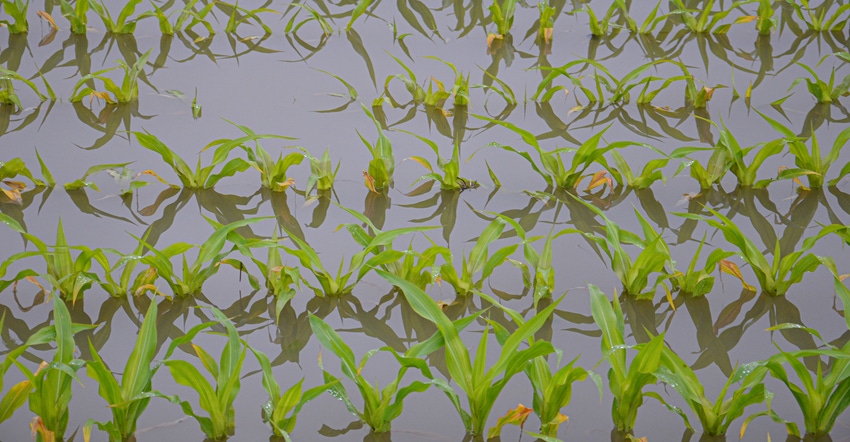
Cornfields across much of the eastern Corn Belt have been saturated, with all or parts of the field under water for varying lengths of time. The worst thing that can happen is plants die. However, Bob Nielsen, Purdue University Extension agronomist, says many other things can happen even if plants survive, and none of them are good.
Here is a baker’s dozen facts about what happens when cornfields are saturated or submerged. Nielsen provided these facts. See his complete description of the effects of ponding and flooding on corn here.
1. Completely vs. partially submerged. Plants completely submerged are at higher risk than plants partially submerged. If plants are only partially submerged, they continue to photosynthesize, although at limited rates.
2. Length of time. Soil oxygen is depleted within 48 hours of soil saturation, and plants need oxygen to live. Nutrient and water uptake is impaired, and root growth is inhibited.
3. Temperature. If temperatures are in the mid-70 degrees F or lower, corn can survive longer than if it’s in the mid-70s and warmer.
4. Mud or old crop residue left on plants. There is reduced photosynthesis and more stress. Ironically, what the field needs is rain to wash off mud.
5. Caked mud. Bacterial and fungal infections can sometimes result after caked mud surrounds plant tissue for an extended period.
6. Age of corn. Corn with six or fewer fully exposed leaf collars, or at the V6 stage, is more susceptible than older corn. With taller corn, the growing point is above ground. On younger corn, split stalks three to five days after water drains off and look for fresh leaves in the whorl.
7. Damage after surface water subsides. Some root death will occur and new root growth will be stunted until the soil dries to acceptable moisture contents.
8. Orange lower leaves. Nitrogen may be rapidly remobilized to upper, newer leaves, causing lower leaves to turn orange or yellow rapidly.
9. Purple plants. Root function in saturated soils deteriorates, meaning roots use less photosynthate material. This material can accumulate in the plant, causing dramatic purpling of leaves and stems.
10. Ineffective roots. If the root system begins to die off, affected plants take up less water. In another ironic twist, plants show drought stress symptoms.
11. Root and stalk rot. The net result of early root damage is susceptibility to root and stalk rot later in the season, since the limited root system will lead to photosynthetic stress during grain fill.
12. Common smut and crazy top. The fungus that causes crazy top needs saturated soil conditions to infect corn seedlings. Common smut can infect young plants by entering tissue damaged by floodwaters.
13. Susceptible to wind damage. Green snap or plants uprooted due to root lodging is more common if flooding or ponding occurs later in the season versus when plants are small.
About the Author(s)
You May Also Like




